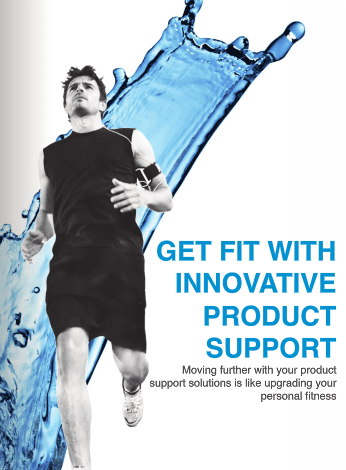John Ragsdale is vice president of technology research for the Technology Services Industry Association. Ragsdale spoke with Alon Bar, marketing manager at Amdocs, a company that helps service organizations better manage their customer relations, about his new e-book, “Get Fit with Innovating Product Support.” Bar discussed strategies companies can adopt to get more than simple maintenance out of their product support teams. Republished with permission from Ragsdale’s Eye on Service.
 John Ragsdale: What a great e-book! I’ve been asked to review quite a few books on support operations, and most are pretty dry. The layout, color and use of graphics in “Get Fit with Innovative Product Support” makes this a fun read. While clearly my body hasn’t seen the inside of a gym for a decade, I also like the way you frame the discussion about embracing new technologies, tools, services and processes by comparisons to personal health and fitness and exceeding health goals. How did this analogy between personal fitness and support organizational fitness first occur to you?
John Ragsdale: What a great e-book! I’ve been asked to review quite a few books on support operations, and most are pretty dry. The layout, color and use of graphics in “Get Fit with Innovative Product Support” makes this a fun read. While clearly my body hasn’t seen the inside of a gym for a decade, I also like the way you frame the discussion about embracing new technologies, tools, services and processes by comparisons to personal health and fitness and exceeding health goals. How did this analogy between personal fitness and support organizational fitness first occur to you?
Alon Bar: Well, for me doing sport was always a way living, I have played handball in a league for about 10 years since I was 7 years old. I have also practiced Karate for more than 15 years until recently, and along the way I did some wind surfing, snowboarding and so on, so when I brainstormed with my marketing team about a creative concept for this e-book, it was just natural that this idea that came up became the winning one.
Ragsdale: Innovation is a recurring theme in your book. In my experience, the most high performing companies embrace innovation and change, and are in a constant state of flux. They also have a healthy appetite for risk, because being innovative means sometimes you fail. Unfortunately, I would say companies that embrace innovation, especially around technology, remain in the minority. How do you encourage companies to take a chance on innovative tools and processes, and get beyond their fear of change?
Bar: In the last two to three years, we have enhanced the value of our support offerings to our customers with many new services, tools and processes. Two of the most significant innovations which required also the highest investment are probably our automated support tool which allows real-time analysis of application logs and problems identification and is also integrated with our support knowledge base to find immediate solutions — and, of course, our product support community, which is fully integrated with the support self service and knowledge base. I can tell you that if these two projects were pending a straightforward ROI, they wouldn’t exist today. But the value and recognition they are bringing today are beyond doubt.
Ragsdale: One of the trends I’ve noticed in customer behavior is an increased demand for personalization: customers want to feel that you understand their unique environments and challenges, and don’t give them “one size fits all” service. You discuss some approaches to personalizing support in your book. Could you give us some examples of personalizing the support experience?
Bar: I won’t spoil it for those who want to read the e-book, but to give just one unique example from the recent year. We have launched a new program called “Product Support Stakeholders” comprised of selected production/application managers from customers that have experienced our products and are able to share their personal views with regards to our product support and maintenance services. This program will allow us to implement valuable service improvements in our product support offering. By now we have engaged more than 25 representatives from our customers into this program, and as I write these lines, six of them are taking part in a unique product support summit we have organized for them as part of the company yearly customer’s event.
Ragsdale: Obviously, social media is impacting support in a big way, from new support channels to product idea storming. My 2011 spending data shows companies continue to have a sizeable budget for online communities and social media. How do you see social service impacting support operations and technologies?
Bar: As I have mentioned earlier, we have launched a product support community last year, and I’m glad to tell that the joining and participation rate are in some cases even exceeding our targets. One thing I can tell to our readers: if you are not there yet, if you are still hesitating, do it! If you do it right it will become one of your most valuable support assets.
Ragsdale: As a manager for Amdocs, how have you been able to incorporate your vision of service innovation into products? Could you talk about some of the innovations in Amdocs products and services that are helping customers embrace change and “get fit”?
Bar: The product support organization is defined as a stakeholder in the product development methodology with the responsibility to define product supportability features. A few examples of supportability features engineered into our products, services and processes in the recent year or candidate for coming versions includes: introducing new features in already released versions rather than waiting for the next version, smooth and easy patch bundles and hot fixes installation, standardization of error messages and adoption of automated installer across products.

Share this: